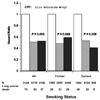Influence of cardiorespiratory fitness on lung cancer mortality
- PMID: 19996990
- PMCID: PMC2859116
- DOI: 10.1249/MSS.0b013e3181c47b65
Influence of cardiorespiratory fitness on lung cancer mortality
Abstract
Purpose: Previous studies have suggested that higher levels of physical activity may lower lung cancer risk; however, few prospective studies have evaluated lung cancer mortality in relation to cardiorespiratory fitness (CRF), an objective marker of recent physical activity habits.
Methods: Thirty-eight thousand men, aged 20-84 yr, without history of cancer, received a preventive medical examination at the Cooper Clinic in Dallas, Texas, between 1974 and 2002. CRF was quantified as maximal treadmill exercise test duration and was grouped for analysis as low (lowest 20% of exercise duration), moderate (middle 40%), and high (upper 40%).
Results: A total of 232 lung cancer deaths occurred during follow-up (mean = 17 yr). After adjustment for age, examination year, body mass index, smoking, drinking, physical activity, and family history of cancer, hazard ratios (95% confidence intervals) for lung cancer deaths across low, moderate, and high CRF categories were 1.0, 0.48 (0.35-0.67), and 0.43 (0.28-0.65), respectively. There was an inverse association between CRF and lung cancer mortality in former (P for trend = 0.005) and current smokers (P for trend < 0.001) but not in never smokers (trend P = 0.14). Joint analysis of smoking and fitness status revealed a significant 12-fold higher risk of death in current smokers (hazard ratio = 11.9, 95% confidence interval = 6.0-23.6) with low CRF as compared with never smokers who had high CRF.
Conclusions: Although the potential for some residual confounding by smoking could not be eliminated, these data suggest that CRF is inversely associated with lung cancer mortality in men. Continued study of CRF in relation to lung cancer, particularly among smokers, may further our understanding of disease etiology and reveal additional strategies for reducing its burden.
Conflict of interest statement
Figures



References
-
- American Cancer Society. Cancer Facts and Figures 2009. Atlanta, GA: 2009. p. 4.
-
- Aadahl M, Kjaer M, Kristensen JH, Mollerup B, Jorgensen T. Self-reported physical activity compared with maximal oxygen uptake in adults. Eur J Cardiovasc Prev Rehabil. 2007;14:422–428. - PubMed
-
- Alfano CM, Klesges RC, Murray DM, Colditz GA, Stampfer MJ, Willett WC. Physical activity in relation to all-site and lung cancer incidence and mortality in current and former smokers. Cancer Epidemiol Biomarkers Prev. 2004;13:2233–2241. - PubMed
-
- American College of Sports Medicine. ACSM's Guidelines For Exercise Testing And Prescription. 7th. 2005. pp. 291–294. - PubMed
-
- Bak H, Christensen J, Thomsen BL, et al. Physical activity and risk for lung cancer in a Danish cohort. Int J Cancer. 2005;116:439–444. - PubMed

